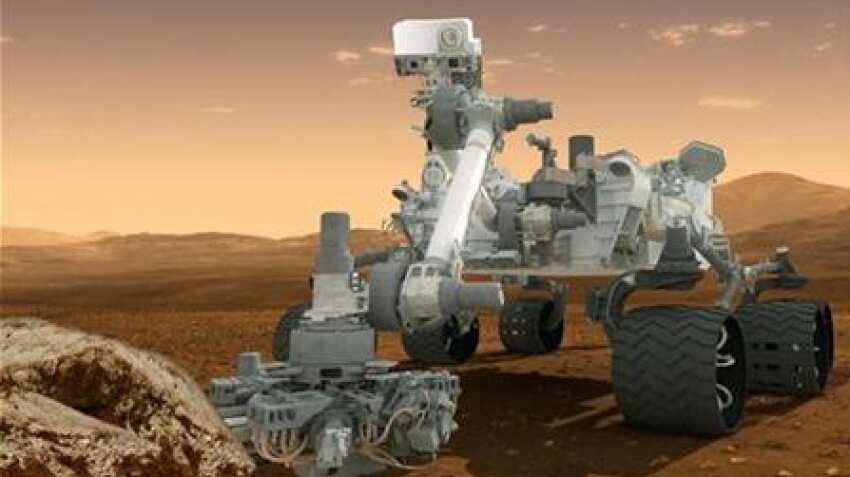Life on Mars? NASA rover helps scientists find signs of megafloods on Mars
Analysing data collected by NASA`s Curiosity rover, scientists have found that floods of unimaginable magnitude once washed through Gale Crater on Mars` equator around four billion years ago

Analysing data collected by NASA`s Curiosity rover, scientists have found that floods of unimaginable magnitude once washed through Gale Crater on Mars` equator around four billion years ago.
The finding, published in the journal Scientific Reports, hints at the possibility that life may have existed on the Red Planet.
The raging megaflood -- likely touched off by the heat of a meteoritic impact, which unleashed ice stored on the Martian surface -- set up gigantic ripples that are tell-tale geologic structures familiar to scientists on Earth.
"We identified megafloods for the first time using detailed sedimentological data observed by the rover Curiosity," said co-author Alberto Fairen, a visiting astrobiologist at Cornell University, Ithaca, New York.
"Deposits left behind by megafloods had not been previously identified with orbiter data."
As is the case on Earth, geological features, including the work of water and wind have been frozen in time on Mars for about four billion years. These features convey processes that shaped the surface of both planets in the past.
This case includes the occurrence of giant wave-shaped features in sedimentary layers of Gale crater, often called "megaripples" or antidunes that are about 30-feet high and spaced about 450 feet apart, according to study lead author Ezat Heydari, Professor of Physics at Jackson State University in Mississippi, US.
The antidunes are indicative of flowing megafloods at the bottom of Mars` Gale Crater about four billion years ago, which are identical to the features formed by melting ice on Earth about two million years ago, Heydari said.
The most likely cause of the Mars flooding was the melting of ice from the heat generated by a large impact, which released carbon dioxide and methane from the planet`s frozen reservoirs.
The water vapour and release of gases combined to produce a short period of warm and wet conditions on the red planet.
Condensation formed water vapour clouds, which in turn created torrential rain, possibly planetwide.
The Curiosity rover science team has already established that Gale Crater once had persistent lakes and streams in the ancient past.
These long-lived bodies of water are good indicators that the crater, as well as Mount Sharp within it, were capable of supporting microbial life.
"Early Mars was an extremely active planet from a geological point of view," Fairen said.
"The planet had the conditions needed to support the presence of liquid water on the surface -- and on Earth, where there`s water, there`s life.
"So early Mars was a habitable planet," he said.
"Was it inhabited? That`s a question that the next rover Perseverance ... will help to answer."
See Zee Business Live TV Streaming Below:
Perseverance, which launched on July 30, is scheduled to reach Mars on February 18, 2021.
Get Latest Business News, Stock Market Updates and Videos; Check your tax outgo through Income Tax Calculator and save money through our Personal Finance coverage. Check Business Breaking News Live on Zee Business Twitter and Facebook. Subscribe on YouTube.
RECOMMENDED STORIES

IPL Auction 2025 Free Live Streaming: When and where to watch Indian Premier League 2025 mega auction live online, on TV, Mobile Apps, and Laptop?

SIP vs PPF: How much corpus you can build in 15 years by investing Rs 1.5 lakh per year? Understand through calculations

SBI Senior Citizen Latest FD Rates: What senior citizens can get on Rs 7 lakh, Rs 14 lakh, and Rs 21 lakh investments in Amrit Vrishti, 1-, 3-, and 5-year fixed deposits
03:49 PM IST








 SpaceX secures $843 million NASA contract to de-orbit ISS by 2030
SpaceX secures $843 million NASA contract to de-orbit ISS by 2030 NASA continues to further India-US iCET initiative for "benefit of humanity", says administrator Bill Nelson
NASA continues to further India-US iCET initiative for "benefit of humanity", says administrator Bill Nelson Indian-origin astronaut Sunita Williams set to fly into space for a third time on Tuesday
Indian-origin astronaut Sunita Williams set to fly into space for a third time on Tuesday China set to launch high-stakes mission to moon's 'hidden' side
China set to launch high-stakes mission to moon's 'hidden' side NASA astronauts lose tool bag during first spacewalk
NASA astronauts lose tool bag during first spacewalk